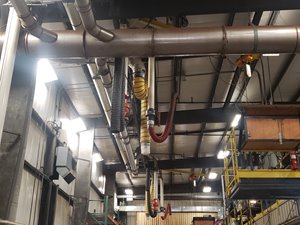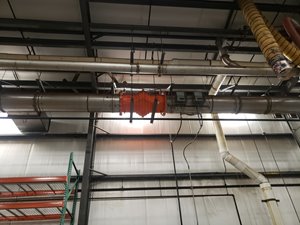Industrial facilities, such as those that specialize in manufacturing a variety of products, including steel making, refining, chemical production, and manufacturing of many consumer products, can be susceptible to fumes that can contain harmful particulates.
These can result from mixing operations, process off-gassing, drying or combustion.
Maintaining a clean work environment is essential to ensure an indoor atmosphere that keeps employees safe and meets regulatory requirements.
Creating a fume management system that meets these goals involves capturing, containing and removing fumes from the air and exhausting it outdoors and/or returning clean air indoors.
What these industrial clients want is a well-designed and maintained fume collection system that properly filters fumes and other hazardous contaminants that they generate through this heavy fabrication. These systems keep facilities compliant and current with air quality requirements.
The work takes a familiarity in working with some different materials, installing them with an eye on fire and explosion prevention and the ability to work with multiple companies on one job. But the benefits are a niche market that has less competition and helps build repeat business with loyal customers.
Becoming specialists in fume management
SMACNA member Vidimos Inc. is an East Chicago, Indiana-based company that specializes in industrial ventilation contracting. From air scrubbers that neutralize hydrochloric acid to thermal oxidizers that incinerate fumes, Vidimos has extensive experience working with the unique duct materials these systems require.
But what really took Vidimos Inc. to the next level was working with a local power company in 2016. The company had a dust collection system that they couldn’t easily move outdoors. So they called in Vidimos to reinforce the system and add an explosion prevention system.
After that, one of Vidimos’ regular customers needed a fire suppression/explosion suppression system.
These two jobs really kicked off this specialized work for Vidimos, giving the company the experience it needed to build trust with these clients.
A turnkey approach to fume management
The process starts with a dust hazard analysis, Vidimos said. This is the best way for an industrial facility to characterize the dust types it generates and evaluate its risk of employee exposure.
In fact, the Occupational Safety and Health Administration stipulates that an employer is responsible for identifying and abating fume hazards in the workplace. Everything from particle size, dust shape, gravity, moisture level, and abrasiveness come into play. Understanding these components lead to the best design of fume control equipment.
Then, there is the design and selection of equipment. “We usually come in on the mechanical hardware installation portion of the job,” Vidimos said. “Sometimes an electrical contractor is also involved for interlocking equipment and sensors. Then, there may be ongoing maintenance and monitoring that is needed.”
Common problems that can happen with this work include:
- Improper mounting of equipment
- Not securing or welding suppressant containers properly to the vessel or duct
- Not properly supporting or bracing process lines or ducting
- Installing duct with incorrect flanges (Ducts must often meet or exceed pressures of -5 to +15 psi)
Material management
Materials required for fume management and mitigation include galvanized and stainless steel, depending on the corrosive nature of the fumes being carried through the duct. Other materials sometimes used, although not usually manufactured by sheet metal contractors, include fiberglass, polyvinyl chloride (PVC) or CPVC, which stands for chlorinated polyvinyl chloride.
Vidimos said knowing how to handle these different duct materials is critical to ensuring a successful project.
“Just being familiar with the types of materials that we’re dealing with, whether it’s a particular type of stainless steel or fiberglass or PVC or CPVC,” he said. “All of them are slightly different.”
The duct materials are usually selected by the client’s engineering staff and not Vidimos engineers. Then for the installation team, protecting the fume management system against corrosion is paramount, Vidimos said.
“When you get into fume management, you’re going to get into stainless steel more quickly than you would with other work because of the potential for corrosiveness,” Vidimos said. “And then with the sealing of joints, instead of just having silicon caulk, you may end up with Teflon gaskets — something that’s impervious to whatever fumes you’re handling.”
The duct that Vidimos fabricates and installs for these projects can range from 6 inches in diameter up to 3 or 4 feet in diameter, he said. A typical project might have 200 to 400 feet of duct. Occasionally, these jobs require up to 1,000 feet.
Exclusive Work = Better Margins
Industrial is a niche market in this industry. It’s a lot less competitive than commercial HVAC, Vidimos said, because fewer people are doing it. And especially in Northwest Indiana, which is an area rife with manufacturing plants, there is a lot of opportunity for this type of work.
When you get deeper into fume and explosion protection, you enter an even more specialized niche. Most of the jobs Vidimos bids are sole-source opportunities. “Just because of that exclusivity, we have the opportunity to make better margins,” he explained.
Having a knowledge of this type of work goes a long way, Vidimos says. “They appreciate our reputation and quality of work,” he said. “It reassures them when they know we’ve worked with these types of systems. It helps our standing in the customers’ eyes.”
And this work continues to present opportunities in industrial-heavy markets, particularly due to continued regulations. “For any contractor working with companies that handle fumes or dust and need a hazard analysis or explosion suppression system,” Vidimos added, “the new regulations have created some great opportunities for contractors to help educate them and see if there are problems they can help solve.

